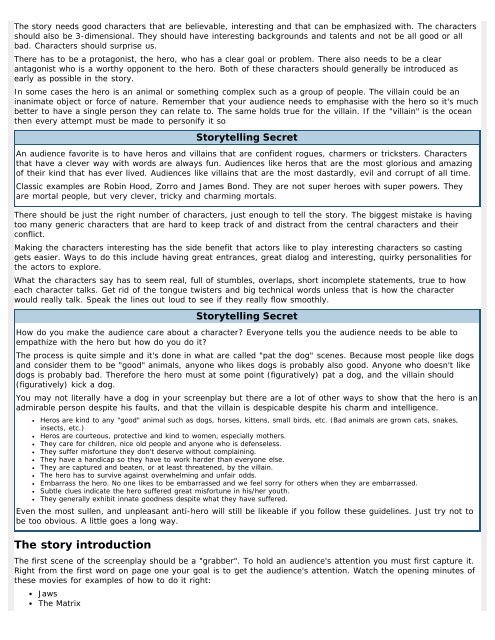The Complete Online Filmmaking Reference - Film Distribution ...
The Complete Online Filmmaking Reference - Film Distribution ...
The Complete Online Filmmaking Reference - Film Distribution ...
You also want an ePaper? Increase the reach of your titles
YUMPU automatically turns print PDFs into web optimized ePapers that Google loves.
<strong>The</strong> story needs good characters that are believable, interesting and that can be emphasized with. <strong>The</strong> characters<br />
should also be 3-dimensional. <strong>The</strong>y should have interesting backgrounds and talents and not be all good or all<br />
bad. Characters should surprise us.<br />
<strong>The</strong>re has to be a protagonist, the hero, who has a clear goal or problem. <strong>The</strong>re also needs to be a clear<br />
antagonist who is a worthy opponent to the hero. Both of these characters should generally be introduced as<br />
early as possible in the story.<br />
In some cases the hero is an animal or something complex such as a group of people. <strong>The</strong> villain could be an<br />
inanimate object or force of nature. Remember that your audience needs to emphasise with the hero so it's much<br />
better to have a single person they can relate to. <strong>The</strong> same holds true for the villain. If the "villain" is the ocean<br />
then every attempt must be made to personify it so<br />
Storytelling Secret<br />
An audience favorite is to have heros and villains that are confident rogues, charmers or tricksters. Characters<br />
that have a clever way with words are always fun. Audiences like heros that are the most glorious and amazing<br />
of their kind that has ever lived. Audiences like villains that are the most dastardly, evil and corrupt of all time.<br />
Classic examples are Robin Hood, Zorro and James Bond. <strong>The</strong>y are not super heroes with super powers. <strong>The</strong>y<br />
are mortal people, but very clever, tricky and charming mortals.<br />
<strong>The</strong>re should be just the right number of characters, just enough to tell the story. <strong>The</strong> biggest mistake is having<br />
too many generic characters that are hard to keep track of and distract from the central characters and their<br />
conflict.<br />
Making the characters interesting has the side benefit that actors like to play interesting characters so casting<br />
gets easier. Ways to do this include having great entrances, great dialog and interesting, quirky personalities for<br />
the actors to explore.<br />
What the characters say has to seem real, full of stumbles, overlaps, short incomplete statements, true to how<br />
each character talks. Get rid of the tongue twisters and big technical words unless that is how the character<br />
would really talk. Speak the lines out loud to see if they really flow smoothly.<br />
Storytelling Secret<br />
How do you make the audience care about a character? Everyone tells you the audience needs to be able to<br />
empathize with the hero but how do you do it?<br />
<strong>The</strong> process is quite simple and it's done in what are called "pat the dog" scenes. Because most people like dogs<br />
and consider them to be "good" animals, anyone who likes dogs is probably also good. Anyone who doesn't like<br />
dogs is probably bad. <strong>The</strong>refore the hero must at some point (figuratively) pat a dog, and the villain should<br />
(figuratively) kick a dog.<br />
You may not literally have a dog in your screenplay but there are a lot of other ways to show that the hero is an<br />
admirable person despite his faults, and that the villain is despicable despite his charm and intelligence.<br />
Heros are kind to any "good" animal such as dogs, horses, kittens, small birds, etc. (Bad animals are grown cats, snakes,<br />
insects, etc.)<br />
Heros are courteous, protective and kind to women, especially mothers.<br />
<strong>The</strong>y care for children, nice old people and anyone who is defenseless.<br />
<strong>The</strong>y suffer misfortune they don't deserve without complaining.<br />
<strong>The</strong>y have a handicap so they have to work harder than everyone else.<br />
<strong>The</strong>y are captured and beaten, or at least threatened, by the villain.<br />
<strong>The</strong> hero has to survive against overwhelming and unfair odds.<br />
Embarrass the hero. No one likes to be embarrassed and we feel sorry for others when they are embarrassed.<br />
Subtle clues indicate the hero suffered great misfortune in his/her youth.<br />
<strong>The</strong>y generally exhibit innate goodness despite what they have suffered.<br />
Even the most sullen, and unpleasant anti-hero will still be likeable if you follow these guidelines. Just try not to<br />
be too obvious. A little goes a long way.<br />
<strong>The</strong> story introduction<br />
<strong>The</strong> first scene of the screenplay should be a "grabber". To hold an audience's attention you must first capture it.<br />
Right from the first word on page one your goal is to get the audience's attention. Watch the opening minutes of<br />
these movies for examples of how to do it right:<br />
Jaws<br />
<strong>The</strong> Matrix


